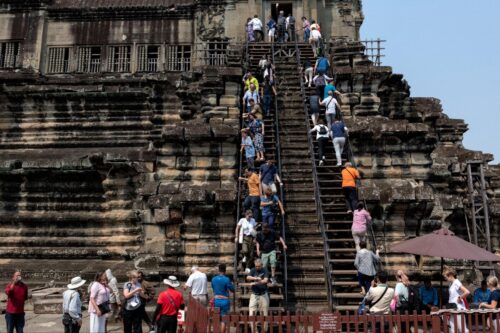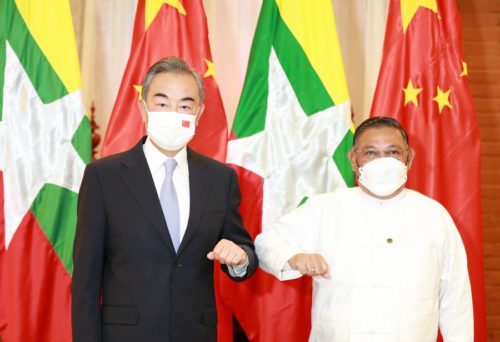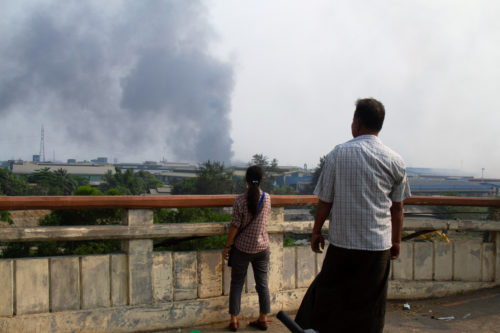China’s (uneasy) relationship with Myanmar, explained
Beijing has remained largely quiet about the coup d'état in Myanmar, a country with which it shares a 1,300-mile border. Examining China's complicated relationship with its "friendly neighbor" might explain why.

On February 1, a coup d’état in Myanmar overthrew the civilian government led by the National League for Democracy (NLD), headed by Aung San Suu Kyi and Win Myint. The country’s military, the Tatmadaw, is now in charge.
The coup has been viewed as the army’s response to its weakening grip over formal power, as well as its growing fears of Suu Kyi’s enduring popularity, despite the pandemic and Rohingya crisis. (Suu Kyi was awarded the 1991 Nobel Peace Prize for her efforts in advancing democratization in Myanmar, but lost much international goodwill after turning a blind eye to the plight of the Rohingya people.) The Tatmadaw declared a state of emergency in the country, and promised to “hand power back to the winning party” following the next election, scheduled for one year from now.
Violent clashes have recently broken out across the country, following two weeks of largely peaceful demonstrations. A 19 year-old protester was severely injured at Naypyidaw, the capital, with unconfirmed reports of casualties elsewhere as crowds gather in large cities such as Yangon and Mandalay. Internet access has been intermittent and controlled by the junta government, which has also implemented legal changes, such as a law requiring people to report overnight visitors and the suspension of a law that prevented security forces from detaining suspects without court approval.
Meanwhile, China, which shares more than 1,300 miles of a land border with Myanmar, has remained largely quiet. “Both the National League for Democracy and the Tatmadaw maintain friendly relations with China,” Chen Hai, Chinese Ambassador to Myanmar, said on Monday, calling the country a “friendly neighbor.”
Myanmar’s relationship with China
China has come under significant criticism. Rumors on social media have alleged that Chinese aircrafts have transported technicians and soldiers to Myanmar, and that the Tatmadaw has sought Chinese assistance in constructing a new firewall for its internet. Chen, however, denied that Beijing had any foreknowledge of the military takeover, and affirmed a recent UN Security Council press statement of “deep concern.”
But even rumors of alleged interference from Beijing has exacerbated long-standing tensions between ethnic Chinese citizens and the Bamar majority in Myanmar (there are 135 officially recognized ethnic groups, with the Bamar making up 68 percent and the Chinese making up 2.5 percent). Much of the ongoing antagonism can be traced back to the two countries’ turbulent historical relations.
While Myanmar (then known as Burma) was the first non-Communist country to recognize the Chinese Communist Party-led People’s Republic of China in 1949, the late 1960s saw a spike in anti-Chinese sentiment that precipitated anti-Chinese riots in 1967 and caused the expulsion of Chinese communities.
Under Dèng Xiǎopíng’s 邓小平 reformist and pacifist foreign policy, China pivoted away from the Communist Party of Burma — the banned opposition party previously headed by Suu Kyi’s father — and opted for neutralization of relations with the military junta. In the aftermath of failed Burmese democracy protests in 1988 (aided by fervent Hong Kong and Singaporean intermediaries), China gradually increased its economic presence in Myanmar in the final decades of the 20th century.
Xí Jìnpíng’s 习近平 Belt and Road Initiative and China’s rapid economic growth saw China surge from occupying a little over 6% of the country’s export volume in 2010 to roughly 33% in 2019. Bilateral trade volume exceeded $12 billion in 2019-2020, rendering China the largest export market for Myanmar.
But Chinese attempts to court domestic support in Myanmar through economic aid and investment — much as its efforts elsewhere in Southeast Asia — have been met with skepticism from the public. Chinese projects are occasionally perceived as economically detrimental or threatening to national security interests.
In 2011, the military junta unilaterally suspended construction work on the Myitsone Dam, a $3.6 billion project driven largely by Chinese capital. More recently, Chinese ventures under the China-Myanmar Economic Corridor (CMEC) have been delayed due to concerns over the country’s indebtedness toward China, as well as significant Chinese ownership over key infrastructural projects (e.g., its holding 85% of the shares over the Kyaukphyu deepwater port).
All of this is to say, the rising tides of anti-Chinese sentiment in Myanmar cannot be attributed to recent grievances alone, but also historical, ethnocentric, and identitarian struggles.
China’s dilemma
It is unlikely that Beijing welcomes the latest developments in Myanmar. On one hand, Beijing can ill-afford to aggravate its already uneasy relationship with the Burmese public, which has overwhelmingly come out in support of the NLD and Suu Kyi — including some of the ethnic minorities that had protested the country’s Rohingya policy. Large-scale infrastructure projects require significant domestic buy-in and manpower, which means the financial and labor support of local officials and businesses is vital. Political strife and ongoing political demonstrations are also likely to pose a threat for China’s international ventures in the country, such as the CMEC.
China finds limited comfort in the Tatmadaw’s resurgence; it was Thein Sein, a military leader, who placed a moratorium on the Myitsone Dam in 2011, and who opened the country up to Western-style reforms. More generally, the military has long remained suspicious of Chinese regional presence, perhaps best epitomized by the current junta chief, Min Aung Hlaing, increasing his embrace of Russian arms over the past decade. An internationally isolated military regime not only undercuts the credibility of hypothetical Chinese threats against Myanmar, but also severely undermines China’s otherwise largely unfettered access to Myanmar’s sizable economic market.
Fundamentally, the NLD has proven to be a sturdy ally to China over the past decade: entering into international trade deals, pledging greater commitments to exchanges in civil society, relations-building as part of the Belt and Road Initiative, etc. Indeed, Xi’s high-profile visit to Myanmar in 2020 cemented multi-billion-dollar infrastructure deals, and Beijing was among the states that openly congratulated Suu Kyi for the NLD’s election victory last November.
On the other hand, China’s hands are tied. Beijing has long adopted the official discourse that countries’ domestic affairs ought to be handled domestically — a principle it cites in repudiating Western criticism of its handling of Hong Kong, Tibet, and Xinjiang. China blocked a proposed UN condemnation on February 3, casting the “new cabinet reshuffle” in Myanmar as a domestic issue. Any attempt to openly call for an end to military rule could risk alienating members of the international community who seek solace in China’s selectively non-interventionist, permissive foreign policy.
Furthermore, Beijing must engage in difficult calculations over the costs and benefits of severing ties with the military regime. If it does so, it risks turning the junta-led country into a capricious pariah state, much like North Korea, or, worse yet, a ticking time bomb which shares a border.
How China reacts to ongoing developments in Myanmar is likely to turn on a multitude of factors — whether the military succeeds at establishing control, whether the U.S. will enter into a tentative agreement on a multilateral intervention that does not contravene core Chinese interests, and the degree to which the NLD and its allies can persuade China to take its side. Given all the unknowns, perhaps it’s unsurprising that China’s stance so far has been to take no stance.





